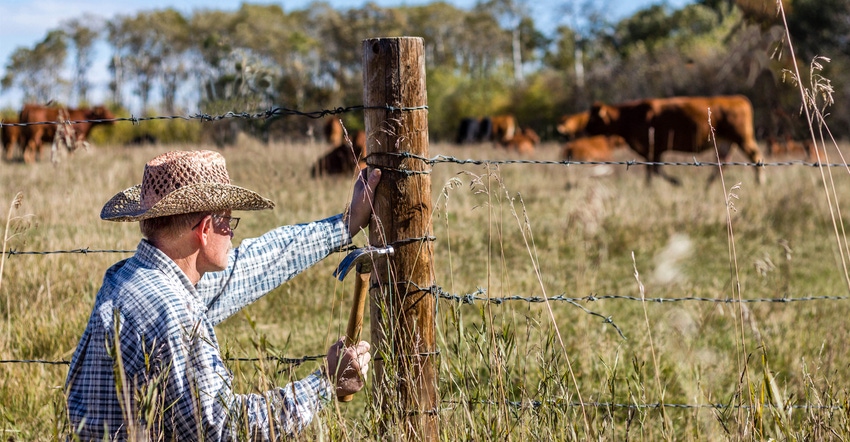
After this spring's blizzards and flooding, fence rebuilding is a priority for many livestock producers. In setting new fences, questions may come up regarding opportunities for financial assistance, as well as neighbor responsibilities as outlined in Nebraska fencing laws.
Financial assistance for fence rebuilding may be available through the USDA Farm Service Agency Emergency Conservation Program. ECP provides emergency funding and technical assistance to farmers and ranchers to rehabilitate farmland damaged by natural disasters.
The program provides cost-share payments for approved emergency conservation practices, including but not limited to restoring fences. Cost share is up to 75% of the cost for emergency conservation practices but is limited to $500,000 per person or legal entity per disaster.
For limited-resource, beginning farmers or ranchers and socially disadvantaged producers, the cost-share may be up to 90%.
Forty-seven Nebraska counties have been authorized to accept ECP applications. Deadlines for applying vary by county. To qualify for ECP cost-share payments, you must apply before acting to repair damages.
FSA is required to comply with applicable environmental laws, regulations and procedures before ECP-related work can begin. The agency has streamlining provisions in place for basic fence repair applications. To be reimbursed, you must maintain receipts for the work, along with documentation of payment.
Note that fencing must meet minimum standards for cost-share payments. Contact your local FSA office for more details. Temporary fencing and fencing that does not meet minimum standards is not covered by ECP.
If you have started repair work without first applying for ECP, you may still be eligible for cost-share payments under certain conditions. The FSA county committee would review and determine whether to approve the application. Contact your local FSA office for information.
Nebraska fencing law
Here are a couple of things to remember about Nebraska fencing law:
Livestock owner responsibility. Nebraska livestock owners are required to use reasonable care to prevent their livestock from escaping their control. Nebraska livestock owners are liable for any damage their trespassing livestock cause when they have not used reasonable care to prevent livestock trespass. Nebraska law does not specifically require livestock owners to fence in their livestock, but that often is the most reasonable and practical way to prevent livestock trespass.
Shared property lines. A general rule of thumb used by Nebraska landowners to establish or maintain shared fence lines is to meet in the middle of the boundary and have each individual look to the right to identify their responsible portion. The part of the fence line to the individual's right is the portion of the fence line the landowner would either establish or maintain.
According to fence laws in Nebraska, landowners are required to equally split the cost of establishing and maintaining a fence to divide their properties unless otherwise agreed upon. Property line fences are not required if neither neighbor wants the fence. However, if one neighbor wants a fence, the fence builder can require the neighbor to pay half the cost of the fence.
If the fence builder is going to pay for the fence, the statute does not restrict the type of fence built. But if the fence builder wants the neighbor to be responsible for half the fence, the fence must be at least four wires, at least No. 9 fencing wire, and attached to posts no more than one rod (16.5 feet) apart, with a post or stake between every two posts.
Barbed wire may be used but is not required. The fence must be at least 4.5 feet high, with no more than 1 foot between wires, measured from the top. If the neighbors both agree, a different type of fence may be constructed.
You must formally serve written notice to the neighbor that you are going to build, maintain or repair the fence. For this, you should get legal assistance. If the neighboring landowner does not live on the land, you must serve the notice to whoever lives there or the owner's agent (probably a tenant).
The written notice must request that the neighbor either build, maintain or repair his or her portion of the fence, or else pay you for doing so. After the written notice has been served, you may begin fence construction, maintenance or repair (unless you have requested that the neighbor do so instead of you).
You do not need permission to go onto your neighbor's land to the extent reasonably necessary to build, maintain or repair the fence. However, you cannot remove trees, buildings, personal property, or other obstacles without either the neighbor's permission or a court order.
In some cases, disputes may arise between landlords on where the original boundary fence was. A property line survey may need to be conducted to establish the official property line before rebuilding fence lines.
If, however, both neighbors agree where the original fence line was located, they may agree to locate the new fence on the old fence line. If either neighbor is contemplating sale of their land, a survey may be desirable before rebuilding the fence.
Groskopf is a Nebraska Extension educator for agricultural economics. Aiken is a Nebraska Extension water and agricultural law specialist.
Source: UNL BeefWatch, which is solely responsible for the information provided and is wholly owned by the source. Informa Business Media and all its subsidiaries are not responsible for any of the content contained in this information asset.
About the Author(s)
You May Also Like




